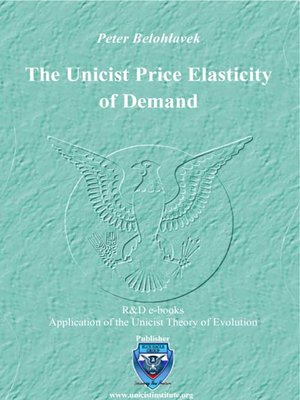
Sign up to save your library
With an OverDrive account, you can save your favorite libraries for at-a-glance information about availability. Find out more about OverDrive accounts.
Find this title in Libby, the library reading app by OverDrive.



Search for a digital library with this title
Title found at these libraries:
| Loading... |
“The Unicist Price Elasticity of demand” theory, not only explained the exceptions to the traditional theory of demand but also gave a unified field to study the evolution of prices by understanding its implicit value.
Empirical applications of The Theory of Demand and the Price Elasticity of Demand left much more to be desired. Too many exceptions to the theory were found.
When a phenomenon has been described and named, an important step in the scientific process has been taken. But the danger point in science is reached when cases that do not fit the definition are brushed aside as “exceptions”.
The method of science, which is to test hypotheses by ascertaining the extent to which the facts verify postulates, admits of no “exceptions”. In this way, the Old Theory of Elasticity of Demand showed so many exceptions which did not and do not verify its own postulates that it must be considered a fallacy.
This fallacy model showed the necessity to develop a Unicist approach to explain the Demand phenomenon.
The first approach to influence demand using price and value approaches occurred in 1981 in Diners Club (credit card market). Since this first successful approach, there were leading cases with American Express, Monsanto, Ciba-Geigy, Massey Ferguson and BASF products, where new tools to approach the price elasticity of demand were used.
Empirical applications of The Theory of Demand and the Price Elasticity of Demand left much more to be desired. Too many exceptions to the theory were found.
When a phenomenon has been described and named, an important step in the scientific process has been taken. But the danger point in science is reached when cases that do not fit the definition are brushed aside as “exceptions”.
The method of science, which is to test hypotheses by ascertaining the extent to which the facts verify postulates, admits of no “exceptions”. In this way, the Old Theory of Elasticity of Demand showed so many exceptions which did not and do not verify its own postulates that it must be considered a fallacy.
This fallacy model showed the necessity to develop a Unicist approach to explain the Demand phenomenon.
The first approach to influence demand using price and value approaches occurred in 1981 in Diners Club (credit card market). Since this first successful approach, there were leading cases with American Express, Monsanto, Ciba-Geigy, Massey Ferguson and BASF products, where new tools to approach the price elasticity of demand were used.






